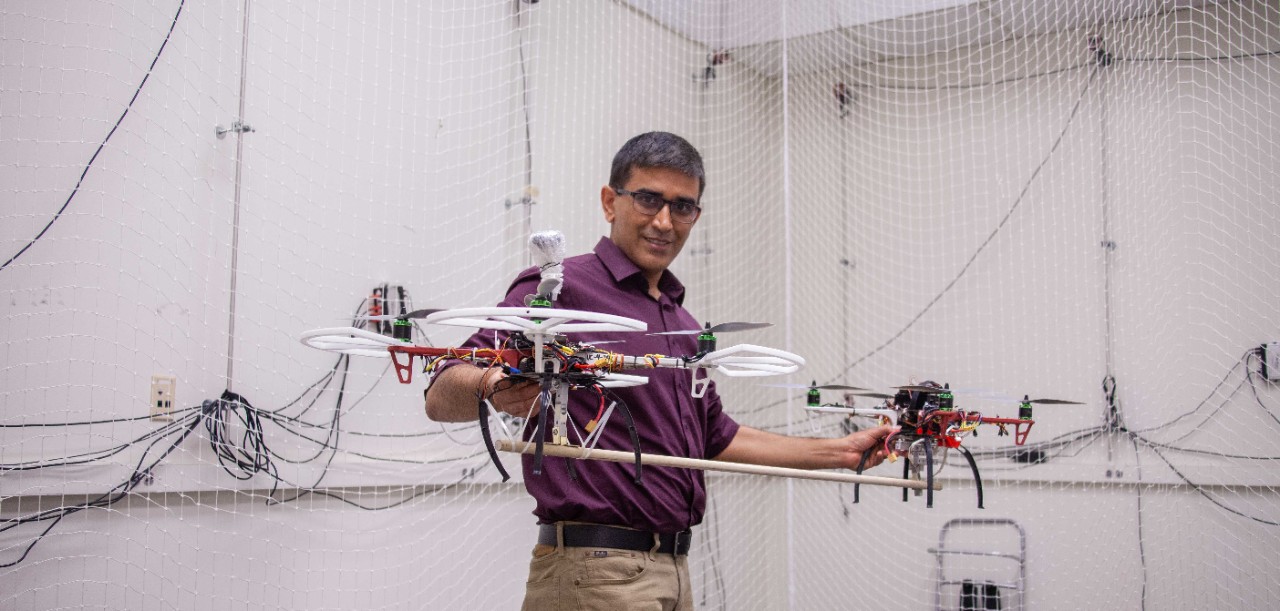
UC's new drone research comes with a catch
Safer and longer-flying, actively tethered drones open skies to more uses
Engineers at the University of Cincinnati have come up with a simple way to improve the safety and utility of flying drones — a leash.
UC researchers have developed a semi-autonomous drone that is moored to the ground and can be operated more safely by virtually anyone. No piloting skills are required. Operators simply move the tether to move the drone.
Tethered drones are often used for stationary monitoring, relying on a source of electricity on the ground to provide longer flight times. UC helped the Ohio Department of Transportation implement some of these systems to monitor traffic or construction projects where an eye in the sky provides a valuable perspective.
“The battery is a big limitation for drone flight time,” said Manish Kumar, a professor of mechanical engineering in UC’s College of Engineering and Applied Science. “Once connected to an electric tether, the drone can operate much longer.”
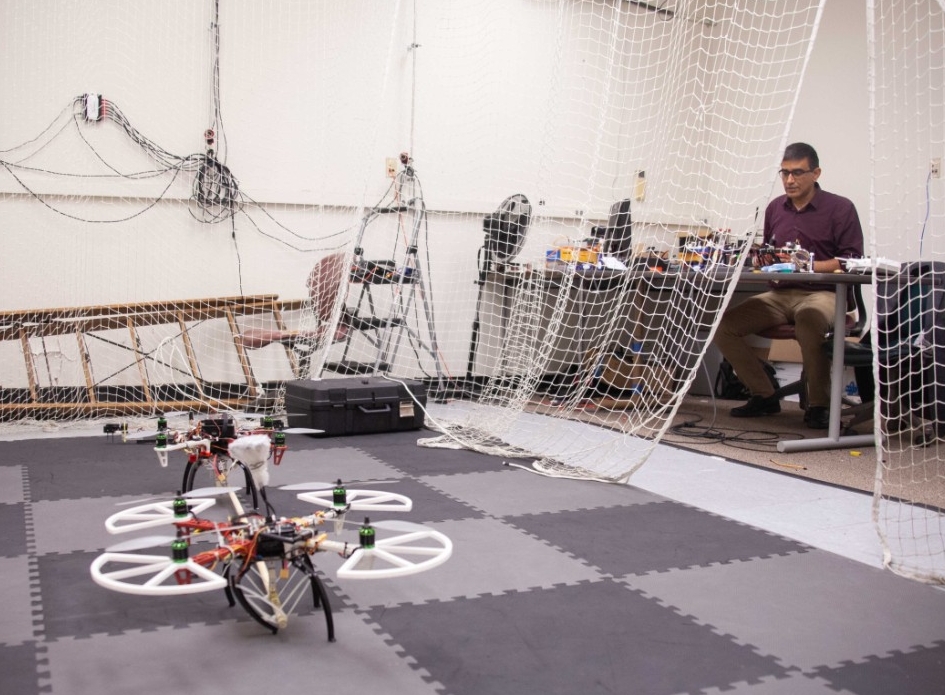
UC College of Engineering and Applied Science professor Manish Kumar work with drones in his flight lab. Photo/Ravenna Rutledge/UC Creative + Brand
A tether can be a thin electric cord, a fiber-optic cable or even something as simple as a kite string. However pulling on a tether can destabilize a typical drone, sending it crashing to the ground. UC engineers fixed that by developing a semi-autonomous navigation system that allows a drone to self-stabilize in the air.
The drone remains stable in the sky in gusting winds or when the user pulls the tether. The user can move the drone simply by walking the tether to a new location like a child carrying a balloon.
The way we fly kites, we can fly drones.
Shraddha Barawkar, UC graduate student
UC’s custom navigation system uses artificial intelligence based on fuzzy logic, a type of computer decision making that relies on degrees of truth rather than a binary true-false dichotomy. This makes it a more robust system because no precise inputs are required.
Kumar demonstrated the system in his lab using a four-rotor drone called a quadcopter attached to a wooden rod. When Kumar pushed or pulled the rod, the drone automatically tilted in the same direction, maintaining its stability and position in the air.
“The way we fly kites, we can fly drones,” UC doctoral student Shraddha Barawkar said.
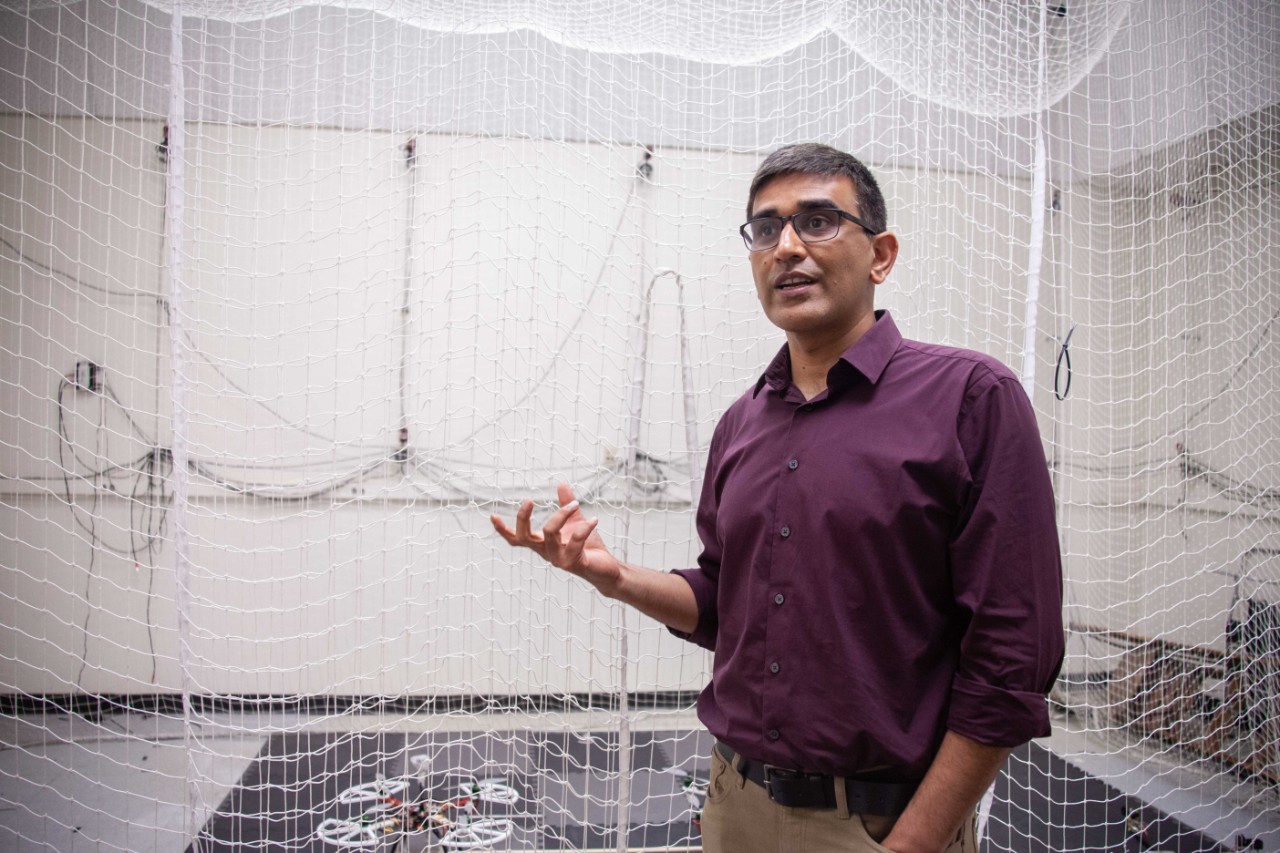
UC College of Engineering and Applied Science professor Manish Kumar is developing innovative navigation and applications for drones in his Situational Awareness Lab. Photo/Ravenna Rutledge/UC Creative + Brand
Improving drone safety
Researchers said tethered drones can be manipulated more safely and easily from the ground. With a tether, the user can restrict a drone’s flight radius and elevation so it can be flown safely around people or in restricted air spaces like airports.
As part of UC’s new Digital Futures initiative, part of the university’s 10-year research plan, Kumar and his students are working in his Situational Awareness Lab to create new innovations for unmanned aerial systems.
Besides longer flight times, tethers offer other big advantages.
“Safety comes first. We want to increase safety,” doctoral student Barawkar said. “With traditional drones, you fly with a remote control or with semi-autonomous navigation. But there’s a risk of it crashing.”
Kumar said the applications are endless — from responding to an emergency to deploying on a battlefield so soldiers on the ground can view terrain from a high vantage point.
“Or even as a children’s toy. It’s inexpensive and it’s safer than an untethered drone,” Barawkar said.
Barawkar, Kumar and Kumar’s frequent research partner Kelly Cohen, interim head of UC’s Department of Aerospace Engineering and Engineering Mechanics, obtained a provisional patent for their tethered drone.
“Tethered drones are connected to the ground to supply the energy required to allow for omnipresent surveillance over a limited area,” Cohen said. “Moreover, the tether allows for secure communication and transfer of information such as a video feed from the air vehicle to a ground station, making it resilient to cybersecurity threats.
“There are many important commercial as well as homeland security applications where tethered drones present immense value and a huge advantage over free-flying drones,” Cohen said.
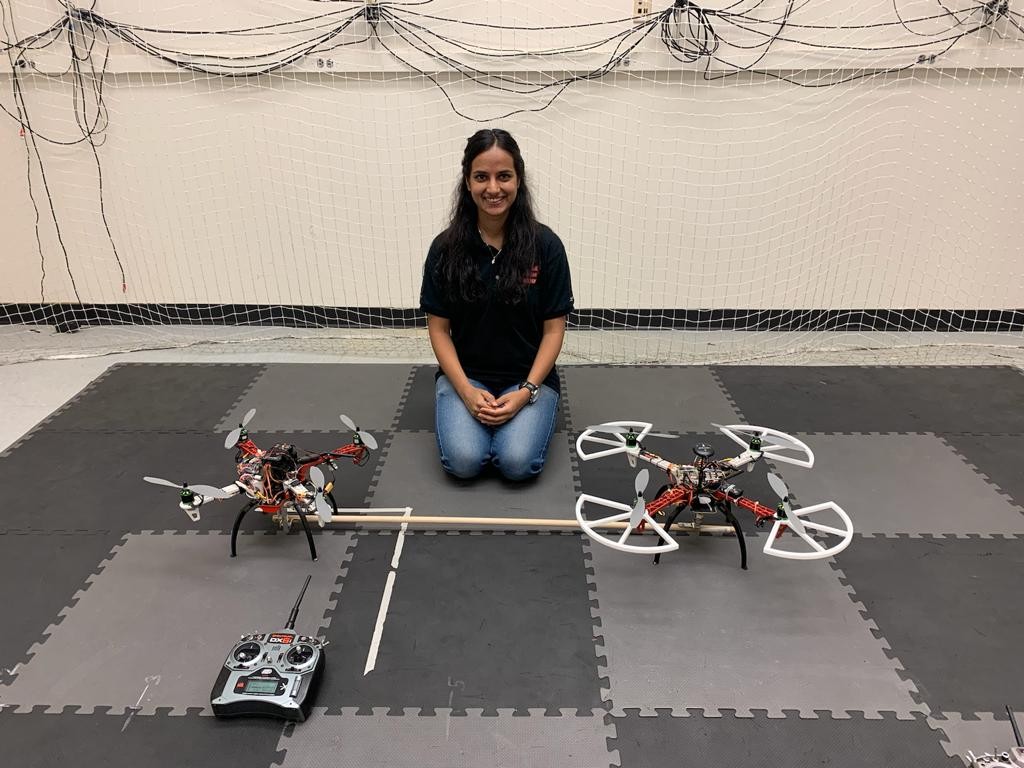
UC College of Engineering and Applied Science student Shraddha Barawkar works with drones in a flight testing area of the Situational Awareness Lab. Photo/Provided
Commercial and public possibilities

UC engineering student Shraddha Barawkar. Photo/Provided
Barawkar said a tethered drone also could offer advantages for interplanetary exploration. NASA celebrated a milestone in April when it launched its first interplanetary drone — a helicopter called Ingenuity that offered aerial views of Mars. During Ingenuity’s sixth flight, NASA said it suffered a navigational glitch that led to unexpected roll and pitch oscillations before safely setting down.
“There are no trees, buildings or other obstacles on Mars, so you could easily use a tethered drone attached to a rover,” Barawkar said.
Such actively tethered drones can operate with fewer federal restrictions under the FAA Reauthorization Act of 2018. Operators don’t need a license, training or certification. And manufacturers aren’t subject to the same standards required for non-tethered drones, which could speed production.
“They feel confident about relaxing those rules because tethers provide more safety,” Barawkar said.

UC engineering professor Manish Kumar. Photo/Ravenna Rutledge/UC Creative + Brand
Barakwar said she was inspired to study drones after seeing the aftermath of the devastating Nepal earthquake in 2015. The earthquake was so strong that it triggered a deadly avalanche on Mount Everest 140 miles away. The quake killed more than 8,800 people in Nepal and others as far away as India, Tibet, China and Bangladesh.
“I wanted to do something during disasters,” she said.
The destruction of the local infrastructure hampered the rescue and recovery.
“They had no technology available,” she said. “My mom says it’s easy to blame, but it’s harder to take responsibility. I thought drones could be helpful in disaster management. You could use tethered drone systems for disasters.”
Kumar said high-flying tethered drones could help reestablish local internet to help improve communications, for example.
“After Hurricane Katrina, one of the big problems was communication. It was hard to appreciate what was taking place on the ground,” Kumar said. “But these drones can be deployed quickly and stay aloft for a long time. They can serve as an ad hoc cellular network and provide better situational awareness.”
Featured image at top: UC engineering professor Manish Kumar is developing a tethered drone that makes automatic adjustments to remain stable in the sky. Photo/Ravenna Rutledge/UC Creative + Brand

UC College of Engineering and Applied Science professor Manish Kumar has developed a semi-autonomous drone that remains stable in the sky when manipulated with a tether. Photo/Ravenna Rutledge/UC Creative + Brand
More UC drone research
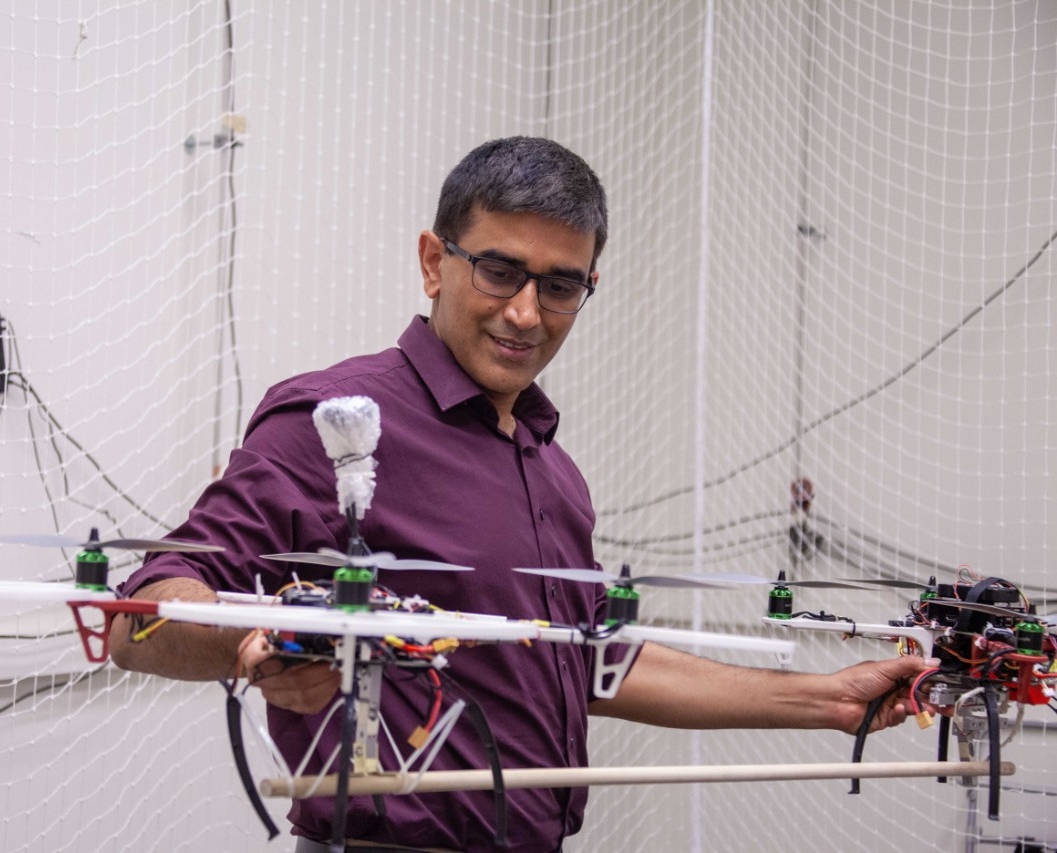
UC is developing new applications for unmanned aerial vehicles. Photo/Ravenna Rutledge/UC Creative + Brand
- UC to help NASA prepare for flying cars
- Futuristic cars may soon take flight
- Forbes: Telehealth drones bring health care to you
- UC takes part in federal drone demonstration
- Graduate student is making drones safer to fly
- UC to study economics of drones in Ohio
- Grad student develops advanced drone technology
- WVXU: How drones can slow the spread of COVID-19
Impact Lives Here
The University of Cincinnati is leading public urban universities into a new era of innovation and impact. Our faculty, staff and students are saving lives, changing outcomes and bending the future in our city's direction. Next Lives Here.
Stay up to date on all UC's COVID-19 stories, or take a UC virtual visit and begin picturing yourself at an institution that inspires incredible stories.
Related Stories
UC researcher launches app to connect patients to lifesaving...
May 7, 2025
A cardiologist and researcher at UC’s College of Medicine joined the Venture Lab at the 1819 Innovation Hub to launch High Enroll, an app that links clinical trials with willing participants.
CCM welcomes opera director and alumnus Jose Maria Condemi to...
May 5, 2025
UC College-Conservatory of Music Dean Pete Jutras has announced the appointment of Jose Maria Condemi, MFA, as CCM's new Associate Professor of Opera. His faculty appointment officially begins on Aug. 15, 2025.
The burning river that fueled a US green movement
May 5, 2025
An article by the BBC takes the reader back to the late 18th and 19th centuries, when US prosperity was defined by the industrial revolution, a time with little regard for the pollutants that came with industrial expansion. UC's David Stradling, professor of history, cited as expert source in the article.
